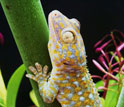News Release 13-062
Not Slippery When Wet: Geckos Adhere to Surfaces Submerged Underwater
University of Akron study may help inform future bio-inspired gecko-like adhesives

A tokay gecko (Gekko gecko) sits on a wet surface prior to adhesion tests.
April 4, 2013
This material is available primarily for archival purposes. Telephone numbers or other contact information may be out of date; please see current contact information at media contacts.
Geckos are known for their sticky adhesive toes that allow them to stick to, climb on, and run along surfaces in any orientation--even upside down! But until recently, it was not well understood how geckos kept their sticking ability even on wet surfaces, as are common in the tropical regions in which most geckos live. A 2012 study in which geckos slipped on wet glass perplexed scientists trying to unlock the key to gecko adhesion in climates with plentiful rain and moisture.
A study supported by the National Science Foundation and published in the Proceedings of the National Academy of Sciences this week solves the mystery, showing that wet, water-repellant surfaces, like those of leaves and tree trunks, actually secure a gecko's grip in a manner similar to dry surfaces.
Researchers from the University of Akron, led by integrated bioscience doctoral candidate Alyssa Stark, tested geckos on four different surfaces. The surfaces ranged from hydrophilic--those that liquids spread across when wet, like glass--to hydrophobic--water-repellent surfaces on which liquids bead, like the natural leaves geckos walk on--and intermediate ones, like acrylic sheets. Geckos were tested on these surfaces both when the surfaces were dry and when they were submerged underwater, and water completely covered the gecko's feet.
Fitting a small harness around the pelvis, geckos were gently pulled along the substrate until their feet began to slip. At this point the maximum force with which a gecko could stick was measured. On wet glass geckos slipped and could not maintain adhesion. However when tested on more hydrophobic surfaces, geckos stuck just as well to the wet surface as they did to the dry ones. When tested, geckos stuck even better to wet Teflon than dry.
To understand these findings, researchers developed a model that explains the results from the gecko study and may also help inform future bio-inspired gecko-like adhesives that can maintain adhesion underwater.
For more details, see: Geckos keep firm grip in wet natural habitat.
-NSF-
-
A tokay gecko (Gekko gecko) clings to leaf stem wet with water droplets.
Credit and Larger Version
Media Contacts
Bobbie Mixon, NSF, (703) 292-8070, email: bmixon@nsf.gov
Denise Henry, University of Akron, email: henryd@uakron.edu
Lisa-Joy Zgorski, NSF, (703) 292-8311, email: lisajoy@nsf.gov
Program Contacts
Andrew J. Lovinger, NSF, (703) 292-4933, email: alovinge@nsf.gov
Related Websites
Geckos keep firm grip in wet natural habitat: http://www.uakron.edu/im/online-newsroom/news_details.dot?newsId=ec9fd559-e4af-487f-a9cc-2ea5f5c9612d&pageTitle=Top%20Story%20Headline&crumbTitle=Geckos%20keep%20firm%20grip%20in%20wet%20natural%20habita
Geckos as inspiration for innovation and new adhesives, an interview with Ali Dhinojwala: http://www.uakron.edu/innovation/gecko.dot
The U.S. National Science Foundation propels the nation forward by advancing fundamental research in all fields of science and engineering. NSF supports research and people by providing facilities, instruments and funding to support their ingenuity and sustain the U.S. as a global leader in research and innovation. With a fiscal year 2023 budget of $9.5 billion, NSF funds reach all 50 states through grants to nearly 2,000 colleges, universities and institutions. Each year, NSF receives more than 40,000 competitive proposals and makes about 11,000 new awards. Those awards include support for cooperative research with industry, Arctic and Antarctic research and operations, and U.S. participation in international scientific efforts.
Connect with us online
NSF website: nsf.gov
NSF News: nsf.gov/news
For News Media: nsf.gov/news/newsroom
Statistics: nsf.gov/statistics/
Awards database: nsf.gov/awardsearch/
Follow us on social
Twitter: twitter.com/NSF
Facebook: facebook.com/US.NSF
Instagram: instagram.com/nsfgov



